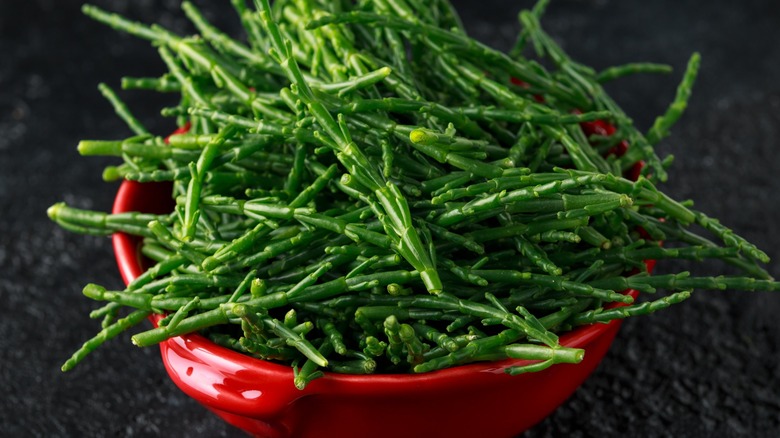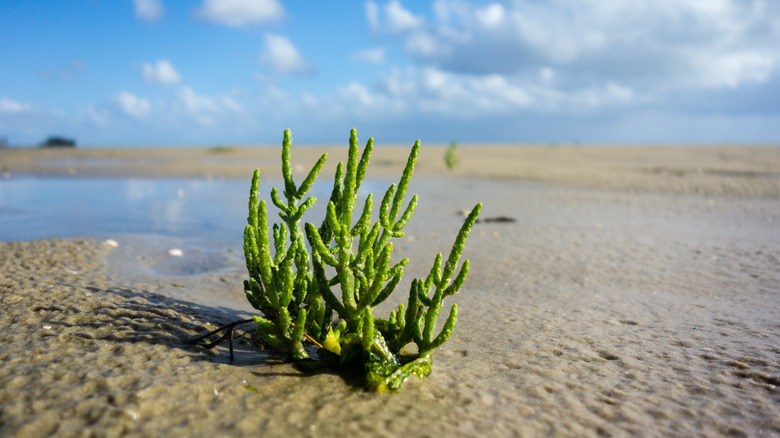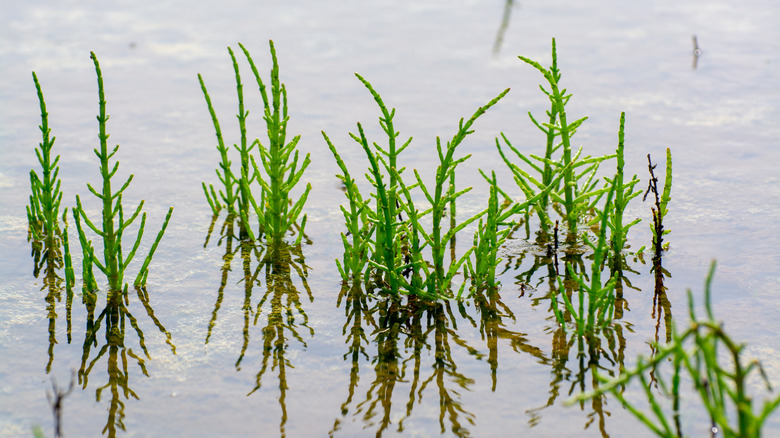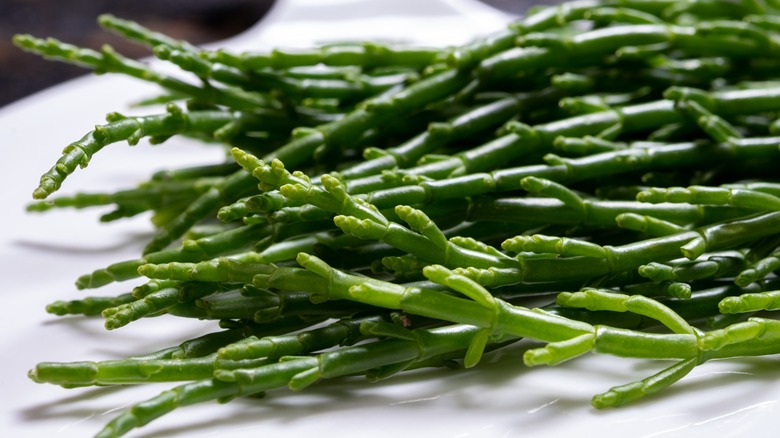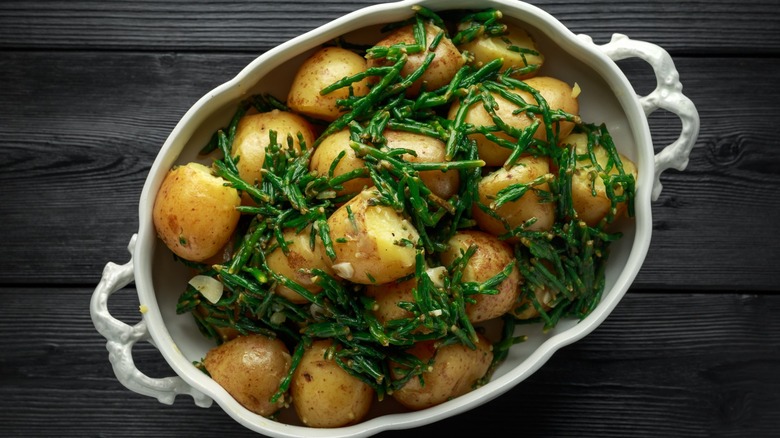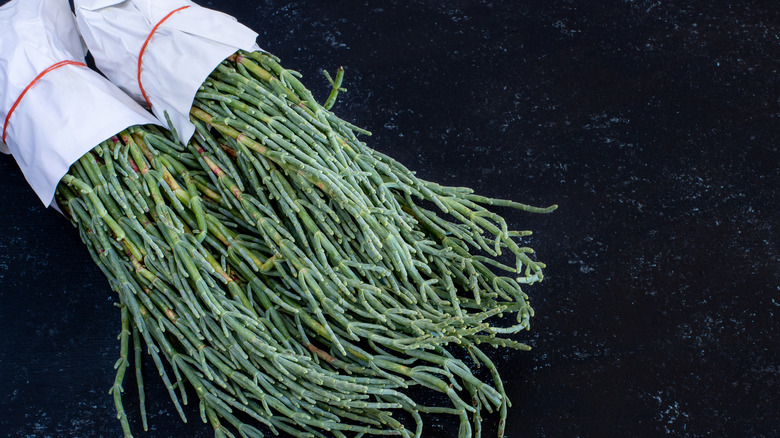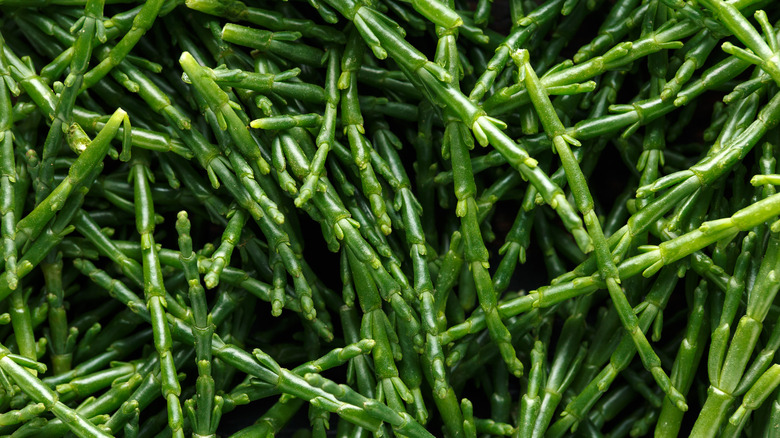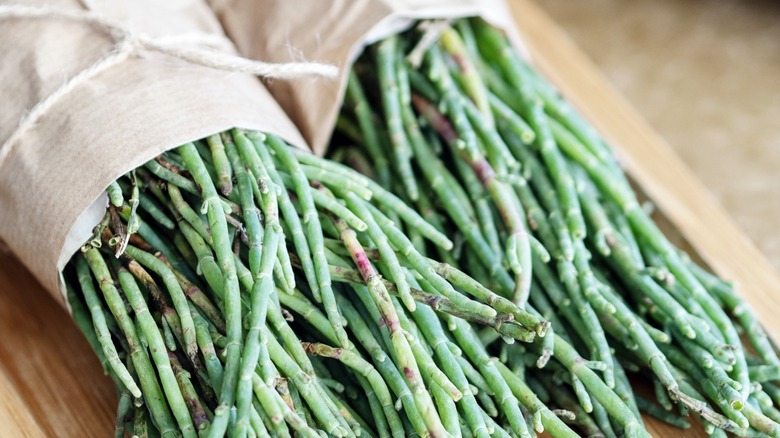What Are Sea Beans And How Do You Eat Them?
In this day and age, you're probably well aware of the various impacts that climate change has had on society — and you've probably experienced some of them yourself. Rising temperatures, forest fires, more frequent and intense natural disasters, flooding, droughts, and the list goes on. But what about the impact it has on the food you eat? Climate change can affect many different areas of the global food supply system, whether it be putting livestock at risk, increasing the spread of disease, reducing nutritional quality, or causing smaller crop yields — and right now, as you are reading this, it's all happening. But there's another problem posing a risk to what you and your community eat: soil salinization.
Soil salinization is a natural process — though it can be accelerated by farming — that occurs when water-soluble salts accumulate in the soil. According to a 2015 study published in the Saudi Journal of Biological Sciences, salinization affects around 7% of the Earth's surface land, rendering it unusable for growing food. That number is expected to increase with projected climate change, salinizing 50% of the planet's agricultural land by the year 2050. However, salt-tolerant plants like sea beans (plants of the genus Salicornia), which thrive in high-saline environments, have the potential to restore these areas. As a result, many scientists believe they might become a key component to feeding a growing global population in the face of climate change. Luckily, they also happen to taste really good.
What are sea beans?
Sea beans – also known as samphire, glasswort, pickleweed, or sea asparagus, depending on where you are in the world — belong to the genus Salicornia. Despite their name, sea beans are not closely related to plants of the bean family. Having the highest salinity tolerance of any plant, sea beans are true halophytes — or, plants that have adapted to growing, reproducing, and germinating within high-saline environments.
Flourishing on saltwater beaches and in coastal marshlands across the Northern Hemisphere and parts of southern Africa from spring to midsummer, these blue foods are technically flowering succulents. They are bright green with swollen, branching stems and resemble clumps of asparagus-like grass. Previously only accessible if foraged from the wild, sea beans have recently been grown and harvested in what's said to be the first-ever indoor saltwater farm.
Heron Farms, which was founded in November of 2020, is a vision realized by environmental scientist Sam Morton. Located in a neighborhood in Charleston, South Carolina, the farm consists of a single, modest-sized room within a warehouse. Heron Farms grows the sea beans in a mix of nutrients and diluted saltwater from the South Carolina coast that's delivered by a local fishing crew weekly. Once mature, they're sent off to local chefs and brewers at Charleston restaurants.
How are they grown?
Of all the water on planet Earth, only 2% is fresh — half of which is frozen inside glaciers. The 1% that is accessible continues to be used irrationally, with more than 70% of it devoted to agriculture alone. The global population is estimated to reach 9 billion people by the year 2050, requiring agricultural production to increase by 50%. In turn, this increases freshwater withdrawals by 15% — which could threaten over half of the world's population by 2050, sending them into a state of increased water shortages. And that's why saltwater agriculture is so integral.
Sea beans, uniquely, are the first crop being farmed this way hydroponically, thanks to an environmental scientist named Sam Norton. Every week, local fishing crews bring 380 liters of salt water to Heron Farms' indoor facility, making it possible to grow them year round. The farmed sea beans are sold to local restaurants, brewers, and consumers, and the profits are then used to replant native sea beans in South Carolina marshes.
Replanting the sea beans in the wild allows the plants to absorb the excess salt in the marshes caused by dredging, which reduces the natural purifying influx of ocean water. Sea beans restore the habitat both by lowering the salinity and creating a storm buffer zone, allowing the marshlands to continue to support the many different species that call it home. There's also the potential to utilize halophytes like sea beans in animal feed to reduce, and even eliminate, the amount of freshwater used for animal agriculture — which, as seen in the case of high water use in beef production, can be a surprisingly large volume.
What do sea beans taste like?
Sea beans have a crunchy, succulent texture that is quite similar to that of green beans, sugar snap peas, and asparagus. Because they grow in seawater, they also provide a satisfying, salty bite — no additional salt or seasoning is required when cooking with them. Their flavor is directly related to their salt absorbency, but, like wine, it's also influenced by their terroir — or, in this case, oceanic merroir — which is their complete, natural environment.
For this reason, sea beans harvested from — or grown using the saltwater from, as is done at Heron Farms — different oceans, coasts, or marshes could taste slightly different, depending on the salinity of the water in that particular place. "When I taste that sea bean, I taste Charleston water," James London, the chef and owner of the Chubby Fish seafood restaurant in downtown Charleston, told Hakai Magazine of Heron Farms' sea beans. "It's the perfect amount of salinity."
But, besides being salty, sea beans are also briny — which, as their name suggests, is a nice way of saying that they taste like the sea. For this reason, some may find that these sea veggies have an almost fish-like taste to them. For culinary purposes, this can have some advantages and disadvantages. But it's all about how you work with them.
Cooking with sea beans
Sea beans are salty — it's all due to their halophytic nature. But they also come with a refreshing crunch and satisfying snap. You can think of them as the ocean's version of your usual green beans or asparagus batches. And, much like their land-grown veggie friends, sea beans are prepared in different ways around the world. In Turkey, for instance, they're commonly blanched in olive oil and garlic, while, in Korea, they are typically dried, ground, blended with sea salt, and used as a seasoning. South Koreans often stir fry them in a dish with glass noodles, Italians toss them in pasta or dress them in lemon juice, olive oil, and burrata, and, in France, they're used just like any other ingredient you'd find in your omelet.
From sea bean coleslaw to tacos, there are a number of recipes you can use for inspiration when cooking with sea beans. In some cases, as in a plant-based tuna salad, their brininess and fish-reminiscent aromas can be used to your advantage, adding that important aspect that's missing from most plant-based fish alternatives. But, in other ways, they can be overpowering, and that's especially true if you don't like the smell of tuna in the first place. The same can be said about how salty they are. Luckily, there are a few ways you can subdue the salinity of sea beans. Whether you're serving them raw, or boiling, roasting, steaming, blanching, or sautéing them, a couple of hours of soaking in some fresh water will do just the trick.
Where to buy them
If you're feeling adventurous, you could venture out into the marshlands and try foraging for sea beans yourself. However, there are other ways to get your hands on them. Sea beans can occasionally be found at specialty grocery stores like Whole Foods, and sometimes even at your local farmers market, even if you don't live in a coastal area. However, the catch is that they're only available for a short time each year— usually only for a few weeks around early May.
But that's what's so great about indoor saltwater agriculture. Not only does it benefit the planet, but it also makes sea beans available all year round. For around $36, you can go online and get yourself 2 pounds of fresh, wild-picked sea beans from Pacific Wild Pick. Heron Farms also sells sea beans fresh, dried, or as a more-convenient bottled green salt for easy storage and application.
Sea beans nutritional information
Being halophytes, sea beans not only absorb salt from seawater but also other valuable ocean nutrients. As one of the best sources of minerals on the planet, the ocean is responsible for much of sea beans' nutritional profile, providing them with high levels of iron, potassium, magnesium, and more. In fact, Heron Farms claims that a serving of sea beans provides more iron than kale, more magnesium than avocados, more fiber than bananas, and even provides a valuable source of vegan omega 3.
However, what's most surprising about sea beans is that, despite their high sodium content and salty flavor, WebMD notes that, when rats consumed them, it did not dramatically alter their blood pressure. This is because sea beans contain a phytochemical called trans-ferulic acid. Trans-ferulic acid is a powerful antioxidant that, according to a 2007 study published in the Journal of Clinical Biochemistry and Nutrition, has anti-aging properties, combats hypertension, and can even reverse the damaging effects of nicotine. All of this makes sea beans a great healthy alternative to salt.
How to store sea beans
When you purchase sea beans, either from the supermarket or from your local farmers market, they'll usually come in bundled bunches. They're typically sold fresh and raw — that is, unless you opt for using them as a green salt or salt-alternative seasoning as they do in South Korea — in which case, you can simply pop the container in your spice cupboard indefinitely, just as you'd probably do with any other seasoning. However, when purchased in their raw form, sea beans require a bit more care.
If you're lucky enough to find fresh sea beans when they're in season, you better make sure you store them right. Sea beans will last for several weeks if you take the right precautions. When you first bring them home, start by giving them a nice rinse. This will remove any of the salt left on their skin and also reduce the amount of water they'll pull from the air. Then, pat them dry and leave them to air dry completely.
Once your sea beans have been rinsed and dried, you can go one of two ways: refrigerate or pickle. In the fridge, your sea beans will last the longest if they're wrapped in a moist paper towel and zipped into a plastic bag, though you can always give them an ice bath to get their crispness back. When pickled, your sea beans will last you several months to a year.
